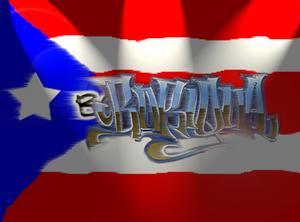A twist in the story of Puerto Rican in hip-hop came with the commercialization and popularity of two Latino-identified genres: freestyle in the late 1980s and Latin rap in the early 1990's. Terminology here provides a bit of confusion, because both were also often referred to as Latin hip-hop. But this apparent terminological confusion actually proves to be illuminating. The term Latin hip-hop points to the fact that both genres were somehow related to, yet distinct from, hip-hop; and key in their difference from hip hop was a share Latin element.
Some artists describe freestyle as "faithful to the old electro sound of 'Planet Roc' adding Latin percussion elements and an overlay of teenage romance" (14). Groups such as Cover Girls, TKA and Lain Raskals and artists such as George LaMond, Sapphire and Brenda K. Starr were among the best know freestyle artists. The overwhelming majority of these were New York Puerto Ricans. Freestyle's audience was also primarily Puerto Rican.
In terms of vocal style, lyrics, and sound, freestyle was very different from the rap music of the time. Freestyle vocalists sang (not rapped) sticky sweet lyrics centered on the vagaries of love, whereas hip hop MCs broached topics more concerned with ghetto life, racial strife, and person/ artistic prowess. Freestyle's sound was electro pop, while hip-hop was usually backed by harsh funk with booming bass lines.
Freestyle, as a new genre, was in great part young Latinos' response to media marginalization-which include marginalization in rap. Discussion of the emergence, popularity, and cultural significance of freestyle must take into account this desire of Puerto Ricans and other Latinos to see "their own" in the limelight, to have a music that was theirs.
Freestyle began as an artistic outlet within a context of Latino media marginalization and a prescribed latinidad belief. Ironically, it also had ghettoizing and stifling consequences in terms of media perception as well as popular cultural identity. Many Puerto Ricans divested themselves from hip hop to pursue something that was truly their own. The commercial popularity of freestyle ended up taking a nosedive that affected not only its artists but also Puerto Rican MCs. Freestyle evolved into Latin hip hop. This cemented the idea that Puerto Ricans were marginal to the hip hop core.
Freestyle was only one side of Latin hip hop. Latin rap fell under the same umbrella. Compared to freestyle, Latin rap stood a lot closer to hip hop in terms of form and style. Vocal flows were rapped, and topics were ghetto centric.
New York Puerto Ricans never ceased being active in the local underground hip hop scene. But in terms of Latin rap's mass mediated exposure, there were nearly invisible.


